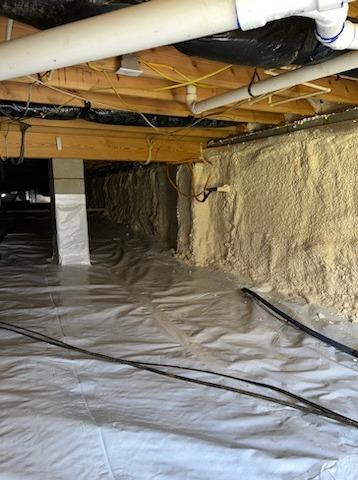Before & After Photos
Click on a photo to enlarge.
Montpelier, VA - Crawl Space Insulation
Fiberglass Batts between the joists absorb moisture like a sponge. They hold moisture against the wood joists and fall and sag over time. Their paper backing and the wood floor joists are organic material that often has mold growing on them. We removed the old insulation and installed new, foam board insulation on the crawl space walls.
Montpelier, VA - CleanSpace Encapsulation System
Previously, this crawl space had a 6-mil lightweight vapor barrier that was torn and even missing in places. We installed the CleanSpace Encapsulation System. The CleanSpace vapor barrier is a heavy-duty 20-mil liner that is perfect for crawl spaces that have service persons working on equipment, plumbing, or electrical, or for storage. It resists rips and tears, and is fastened to the walls and wrapped around piers sealing the earth off from the home.
Insulating and Sealing a Montpelier, VA Crawl Space
This homeowner in Montpelier was having moisture issues within the crawl space of their home. As a result of the excessive outside influence, their home was uncomfortable and the energy bills were high. We encapsulated their crawl space using a CleanSpace Light vapor barrier to help seal off the earth's moisture from the crawl space. Then, we sprayed an inch and a half of closed-cell R-10 spray foam over the foundation walls. All penetrations and vents are also sealed, and the spray foam acts as an air barrier and vapor retarder, protecting the crawl space from the outside influence. With their crawl space encapsulated and insulated, the homeowner should enjoy a much more comfortable home with lower energy bills. If you are interested in sealing your crawl space or basement, then give us a call at 1-866-632-5870. We'll help to keep the outside, outside!
Midlothian, VA Crawl Space Encapsulation
Initially, this crawl space was encapsulated with a 6-mil vapor barrier and R-11 vinyl faced fiberglass insulation. Thhomeownerer contacted us with concerns about an ammonia, or animal urine odor in her home and poor air sealing.
Our goal was to remedy the Home Owner’s concerns of foul odors in her home and wasted energy. To achieve this, we installed a 20 mil Clean Space Vapor Barrier on the floor of the crawl space and around the piers. We installed Foamax board insulation on the walls leaving a 3-inch viewing strip for pest control companies to do their inspection. We applied spray foam insulation to the rim and band and sill plate to create an air seal and reduce drafts coming into the crawl space. Finally, we installed a Sani Dry Sedona Dehumidifier, the leading dehumidifier on the market, to pull any moisture that enters the crawl space out.
Crawl Space Encapsulation in Midlothian, VA
This crawl space was originally encapsulated at construction with a 6 mil Vapor Barrier and R-11 vinyl faced fiberglass insulation. The homeowner complained of an animal urine or ammonia odor in their home. This was a result of moisture entering the crawl space through the porous cinder block walls and saturating the fiberglass insulation.
We installed a 20 mil Clean Space Vapor Barrier, Foamax Insulation Board, sealed the rim & band and sill plate, and installed a SaniDry Sedona Dehumidifier. This approach will help keep moisture out of the crawl space and control relative humidity.












